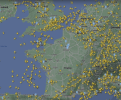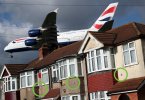LNW-GW Joint
Veteran Member
Tracking a family member's flight back from Singapore to Heathrow, I noticed considerable variation in the routeings of different airlines.
The flight I was monitoring was BA12, an A380.
Taking off just before and after were QF1 and SQ322, both also A380s heading to Heathrow.
But instead of flying together they took quite different routes and SQ322 ended up arriving first, having left Singapore last.
The same pattern showed up on 3 successive nights, so seems to be baked into the timetable.
QF1 took a more westerly track to the Gulf, starting with flying the length of Sumatra.
BA12 initially took a more northerly track closer to Malaysia, but after India turned west and headed to the Gulf, then like QF1 via Baghdad and Turkey to Varna and up through Europe.
SQ322 took a similar track to BA12 initially, but then trended northward over India, then Pakistan, skirting Afghanistan and then over Iran (Tehran) and northern Turkey.
With a shorter route, it overtook BA12 and QF1 to arrive first at Heathrow.
BA and QF were also delayed by looping over Epping before gaining the flight path into LHR (all this around 0600, hardly peak time).
I've noticed that Lufthansa also flies over Iran (as do the Gulf and far-eastern airlines).
So not all EU airlines avoid Iranian airspace.
While Afghanistan airspace is normally empty, I did notice a BA flight (Delhi-Heathrow) overflying the country, so there mustn't be a complete ban.
Other "no fly" zones are Syria, Sudan/South Sudan (flights eg to Ethiopia do a dog-leg via Jeddah) and Yemen.
Plenty of airlines still overfly Russia, but none from the EU/UK/US, though everything avoids Ukrainian airspace and the adjacent areas of Russia.
All this means that different airlines have different routeing policies, and therefore different flight times to its competitors.
No doubt it also shows up in an airline's costs and commercial performance.
Finnair, for instance, which once had an advantage by flying to far east over Russia, now has to go a long way south to join the non-Russia path via Baku.
Turkish Airlines, which can fly over Russia, also serves St Petersburg/Moscow by flying via Poland, as the Russian route avoiding the war zone via the Caspian is longer.
The flight I was monitoring was BA12, an A380.
Taking off just before and after were QF1 and SQ322, both also A380s heading to Heathrow.
But instead of flying together they took quite different routes and SQ322 ended up arriving first, having left Singapore last.
The same pattern showed up on 3 successive nights, so seems to be baked into the timetable.
QF1 took a more westerly track to the Gulf, starting with flying the length of Sumatra.
BA12 initially took a more northerly track closer to Malaysia, but after India turned west and headed to the Gulf, then like QF1 via Baghdad and Turkey to Varna and up through Europe.
SQ322 took a similar track to BA12 initially, but then trended northward over India, then Pakistan, skirting Afghanistan and then over Iran (Tehran) and northern Turkey.
With a shorter route, it overtook BA12 and QF1 to arrive first at Heathrow.
BA and QF were also delayed by looping over Epping before gaining the flight path into LHR (all this around 0600, hardly peak time).
I've noticed that Lufthansa also flies over Iran (as do the Gulf and far-eastern airlines).
So not all EU airlines avoid Iranian airspace.
While Afghanistan airspace is normally empty, I did notice a BA flight (Delhi-Heathrow) overflying the country, so there mustn't be a complete ban.
Other "no fly" zones are Syria, Sudan/South Sudan (flights eg to Ethiopia do a dog-leg via Jeddah) and Yemen.
Plenty of airlines still overfly Russia, but none from the EU/UK/US, though everything avoids Ukrainian airspace and the adjacent areas of Russia.
All this means that different airlines have different routeing policies, and therefore different flight times to its competitors.
No doubt it also shows up in an airline's costs and commercial performance.
Finnair, for instance, which once had an advantage by flying to far east over Russia, now has to go a long way south to join the non-Russia path via Baku.
Turkish Airlines, which can fly over Russia, also serves St Petersburg/Moscow by flying via Poland, as the Russian route avoiding the war zone via the Caspian is longer.




